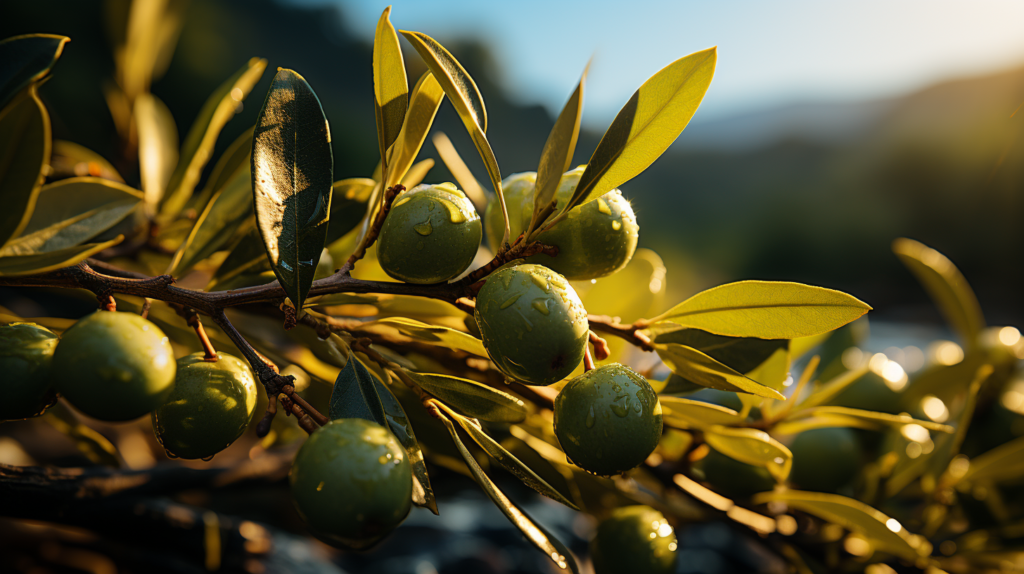The olive tree, this majestic tree emblematic of the Mediterranean, goes through five distinct phases throughout the year. Each phase presents its own challenges and issues, making olive cultivation an adventure in itself.
We invite you on a fascinating journey through the annual cycle of the olive tree. From the dormancy of winter, where the tree enters a vegetative rest, to the spring explosion of new shoots and flowers, passing through the summer growth of the fruits, each stage is crucial. Finally, we reach the frenzy of the autumn harvest, a much-anticipated moment when the ripe fruits are picked to produce precious olive oil.
Dive with us into this natural cycle, rich in traditions and expertise, and discover the secrets of this millennial tree.
The Winter Phase
Let’s start with the cold period. From December to February, the olive tree is in a state of vegetative rest. During this time, the tree does not grow. It is in winter dormancy, requiring neither irrigation nor intensive maintenance. However, it is essential to remain vigilant against frosts, which can cause significant damage.
From March, with the rising temperatures, the sap begins to rise back in the branches. Specifically, as soon as the temperature reaches 12°C, the olive tree comes back to life and exits its vegetative stage. The first signs of this rebirth are visible through the budding of new leaves and the preparation for flowering.
The Spring Revival
From April to June, spring, often synonymous with renewal in nature, also marks a crucial period for olive trees. This season, though promising, brings its own set of challenges. Olive trees emerge from their winter dormancy and prepare for flowering and fruit set*. The health of the tree and the management of seasonal issues during this period largely determine the quality and quantity of the future harvest. Pruning the tree is also important to ensure good aeration. This pruning helps create a healthier environment, reducing the risk of pest pressure.
What happens to the olive tree during this period? Floral buds appear and bloom, marking the beginning of the flowering phase. These buds open to produce flowers ready for pollination. Unlike many other fruit trees that rely on insects for pollination, the olive tree uses anemophilous fertilization, meaning that pollination occurs via the wind.
This method of wind pollination makes the olive tree particularly sensitive to weather conditions. A windy and dry spring can favor good pollination, while a rainy or too calm spring can hinder this crucial process. Therefore, the care given to olive trees and the attention paid to weather conditions during this phase are essential to ensure an abundant and high-quality harvest.
Spring is the ideal time to prevent diseases and pest infestations. To anticipate your protection needs, it is the perfect moment to start researching and planning solutions against the olive fly, such as the Push&Pull solution by Cearitis, to implement at the appropriate time
The Fruiting Phase
Starting in June, the white flowers of the olive trees give way to small green olives, marking the beginning of the fruiting phase. At the onset of summer, the fruits begin to develop. From just a few millimeters, they gradually grow and change color over several months to become the olives we use for oil or as table olives.
However, this period is also marked by challenges, particularly infestations by pests such as the Bactrocera oleae, the olive fly. Solutions, like the one proposed by Cearitis, are available to address these infestations. Indeed, the Push&Pull method is applied in the orchard: REMO® is diffused on the tree and fruits, acting as a repellent to divert the fly towards an autonomous and innovative trap containing our attractant, SAMO®, thereby capturing these pests.
With these protective measures in place, the fruits can develop serenely and ripen until the harvest, which takes place from early autumn until January, depending on the variety of the tree.

The long-awaited moment : harvest
From October until January, the olive harvest period begins. The ripe fruits are carefully picked by olive growers. In France, in 2021, the industry’s harvests reached about 4,500 tons of olives, a significant production reflecting the importance of this cultivation in certain regions, notably Provence-Alpes-Côte d’Azur, Occitanie, and Corsica.
Harvesting is a crucial stage that requires expertise and patience. The methods of harvesting can vary, ranging from traditional manual picking to the use of modern machines. This phase marks the culmination of a year of attentive care and constant efforts to protect and nourish the olive trees.
Once harvested, the olives are sorted and destined either for olive oil production or direct consumption. About 90% of the harvested olives are used for oil production, while the remaining 10% are processed as table olives. Each step, from harvesting to processing, is essential to ensure the quality of the final products.
This journey through the different phases of the olive tree is much more than a simple agricultural story. It is a dive into the heart of millennia-old expertise, rich in traditions and innovations. Modern solutions, such as those proposed by Cearitis with its Push&Pull method, play a crucial role in the protection and growth of olive trees.
By exploring each stage of the olive tree’s cycle, we better understand the importance of every detail and the delicate balance that allows this majestic tree to thrive year after year. Thanks to the expertise and innovations brought by companies like Cearitis, the future of olive cultivation remains promising, combining tradition and modernity for sustainable and productive agriculture.
*Fruit set : this is the fruit formation stage